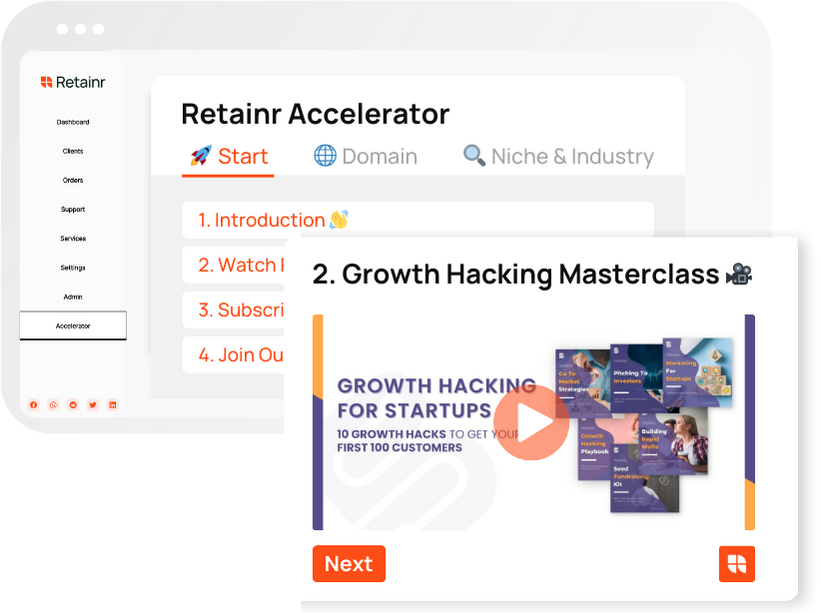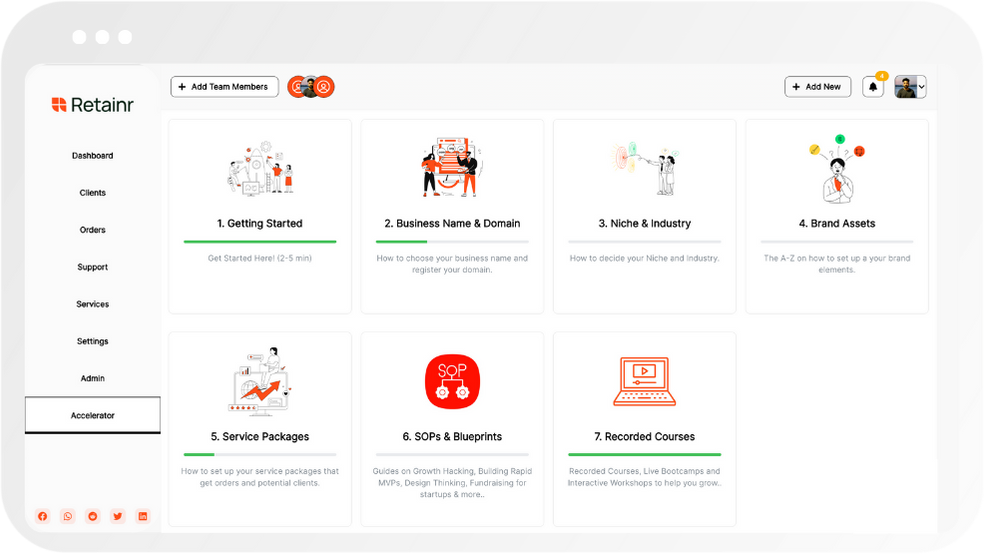
5 Hacks for Integrating Chatbots with Your Existing Systems
Build with Retainr
Sell your products and services, manage clients, orders, payments, automate your client onboarding and management with your own branded web application.
Get Started1. What are some good hacks to integrate chatbots in my existing systems?
Understanding and Using Chatbot APIs
The first hack concerns the usage of APIs (Application Programming Interfaces). APIs are integral in making your chatbot communicate with your existing systems swiftly. Whether your system is based on CRM, eCommerce, or any other databases, APIs can pass crucial data between chatbot and existing systems. This, in turn, will trigger suitable responses from your chatbot. A list of APIs that are commonly used includes:
- REST APIs
- JSON-RPC
- XML-RPC
A decision on the exact API to utilize will hinge on your system's nature and the exact data you wish to access.
Use of Webhooks
The second useful hack revolves around the usage of webhooks. Webhooks give real-time updates whenever certain events occur in your system. For example, a webhook can alert your chatbot anytime an order is placed on your eCommerce platform. Subsequently, the chatbot can send an automatic message to your customer to confirm the order or thank them for the purchase. Sample responses are:
| Triggering Event | Chatbot Response |
|---|---|
| New order | "Your order has been received and is being processed." |
| Order shipped | "Your order has been dispatched." |
Leverage Existing Chatbot Platforms
Lastly, for a smooth integration process, leverage existing chatbot platforms. Many of these providers offer simple methods for integrating with common systems, such as Shopify for ecommerce or Zendesk for customer service. These platforms also have detailed documentation and technical support to assist mix your chatbot with any proprietary systems.
- Chatfuel
- ManyChat
- MobileMonkey
This will be beneficial, especially if your in-house resources are limited.
2. How can I seamlessly integrate chatbots in my current customer service system?
Existing CRM Integration
Integrating a chatbot with your existing customer service system, specifically a Customer Relationship Management (CRM) system, can streamline operations and improve efficiency. First, identify the CRM system you are currently using and select a chatbot platform that can efficiently integrate with it. In terms of out-of-the-box solutions, for Salesforce you have options such as NativeChat while for Hubspot considering Motion.ai could be beneficial. Plus, API.ai and Botpress are traditionally suitable for an extensive range of CRM systems. Secondly, ensure bidirectional synchronization between the bot and your CRM. This means all customer interaction data between the chatbot and customer should directly update in the CRM and vice versa.
Maximizing Integration
Maximizing the functionality and utility of a chatbot requires several key steps. The first is data context awareness, wherein the chatbot has a real-time understanding of user data to provide personalized interaction. Another is creating a seamless user interface. Users should be able to use the chatbot function without feeling that they have been shifted to a different platform or service. Finally, chatbot functionality should be designed to address common customer inquiries, freeing up customer service for the more complex issues.
Measuring Success
Once integration is successful, it is crucial to regularly check the performance and make necessary adjustments. This can be visualized through tables that spotlight Key Performance Indicators (KPIs).
| Metric | Description |
|---|---|
| User Retention | Monitors repeat users over a certain period. |
| Engagement Rate | Tracks how often users interact with the chatbot. |
| Resolution Time | Measures amount of time taken for the bot to resolve customer issues. |
These quantitative measures can provide key insights on improving and optimizing the bot experience for users.
3. What are the benefits of integrating chatbots into my existing systems?
Benefits of Integrating Chatbots
There are numerous benefits to integrating chatbots into your existing systems. Some of the most significant advantages include increased efficiency, improved customer service, and cost reduction. With the prevalence of AI technology, more businesses are seeing the value in using chatbots to streamline their operations and improve customer interactions.
Increased Efficiency and Improved Customer Service
- 24/7 availability: Chatbots can handle customer inquiries at any hour, ensuring continuous, round-the-clock service.
- Instant responses: Customers expect fast responses to their inquiries. Chatbots can provide immediate assistance, answering basic questions or directing customers to the appropriate resources without delay.
- Reduced errors: Chatbots follow coded instructions accurately, reducing the risk of human error in the provision of information.
- Personalised experience: Chatbots can be programmed to provide personalised recommendations and responses based on past interactions, providing a customised experience for each user.
Cost Reduction
| Areas of Saving | Explanation |
|---|---|
| Customer Support | By utilising chatbots, businesses can reduce the number of human agents required for customer service, significantly reducing payroll expenses. |
| Data Processing | Chatbots can process and analyse customer data more quickly and accurately than humans, eliminating the cost of manual data processing tasks. |
| Training | Chatbots do not require traditional training or onboarding, slashing the expenses related to staff development. |
4. Can you guide me through the process of integrating chatbots into my current system?
Understanding Your Current System
Firstly, analyze your current system resources. This may include your CRM, customer service software, financial applications, and any other management platforms. You should map out the data flow from these systems, evaluate their APIs and identify any potential issues or bottlenecks. Consider whether:
- The system's API supports integration with chatbots.
- Your current system can handle the additional workload chatbots may demand.
- The data you need from your current system is readily available and formatted correctly for chatbot use.
Choosing The Right Chatbot Platform
Next, decide which chatbot platform to integrate. It must be compatible with your current system, able to handle your anticipated message volume, and offer the specific features your business needs. A comparison of some well-known chatbot platforms can be found in the table below.
| Chatbot Platform | Features | Compatibility |
|---|---|---|
| Chatfuel | No-coding interface, social media integration, allows for custom AI development. | Compatible with most systems with open JSON API |
| ManyChat | Drag-and-drop chat builder, e-commerce integrations, segmentation and broadcasting tools. | Works best with CRM systems; has limited API. |
| Microsoft Bot Framework | Rich dialogues, multiple languages, can integrate with various channels, Cortana integration. | Strong in enterprise systems, particularly Microsoft based. |
Integration And Testing
After choosing a chatbot platform, use offered APIs and webhooks to integrate the chatbot into your system. This process may vary depending on the platform and your current system's capabilities. It often involves linking the chatbot platform to your databases or management platforms. Once the integration is done, perform tests to ensure:
- Proper functioning of chatbot on all platforms.
- Seamless data syncing between the chatbot and your systems.
- Response outcomes and routes are as per your expectations.
5. What are the top five hacks for efficiently integrating chatbots with existing systems?
Hack 1: Use API Integrations
APIs are the secret backbone of connecting different services. Utilizing APIs for chatbot integration can save significant time spent in setting up complex systems. APIs can send data to the chatbot and receive responses in return, facilitating seamless communication between different systems. An example could be integrating a CRM system's API with the chatbot to provide customer data when needed.
Hack 2: Leverage Existing Chatbot Platforms
There are multiple chatbot platforms already available in the market like Dialogflow, Chatfuel, ManyChat and more. These services integrate well with various systems for website implementation, social media platforms, messaging services etc. Their easy-to-use interfaces and pre-built templates can make the integration process more efficient.
- Dialogflow: Good for voice-based bots.
- Chatfuel: Suitable for Facebook Chatbots.
- ManyChat: Works well for marketing campaigns.
Hack 3: Use Webhooks for Extending Functionality
Webhooks act as a bridge by sending real-time data from one application to another. For example, if a system needs to pass information to your chatbot upon certain triggers, webhooks can manage it efficiently. Here's a comparison table of different webhook services:
| Service | Pros | Cons |
|---|---|---|
| Zapier | Easy to set up; connects with over 1,000 apps. | Limited free plan. |
| Automate.io | More than 100 apps integration. | Free plan limitations. |
| IFTTT | Free to use; good for IoT devices. | Limited to personal use only. |
Hack 4: Consider AI and NLP Capabilities
Artificial Intelligence and Natural Language Processing can take your chatbot to the next level as they facilitate better understanding and interaction with human language. Machine Learning libraries like TensorFlow or services from Google Cloud, IBM Watson, and AWS can assist the AI integration process. NLP libraries like NLTK, spaCy, or services like Wit.ai can enhance your bot's language understanding capabilities.
Hack 5: Robust Testing
Robust testing should be a priority to ensure smooth and efficient integration. Manual testing, automated testing and user testing can help identify any bugs or shortcomings within the system. Services like Botium (for automated testing), and sharing the bot within a small group of end-users for user testing can be extremely useful.
6. Are there any technical limitations to integrating chatbots with my current systems?
Technical Limitations to Integrating Chatbots with Current Systems
While chatbots are an innovative technology that can highly enhance your customer service and overall user experience, you might face some technical limitations when integrating them with your existing systems. Understanding these potential challenges can help you plan your integration more effectively:
- Compatibility issues: Not all systems are designed to be compatible with chatbots. Sometimes, you might need to perform substantial system upgrades or modifications to enable this integration.
- Data privacy concerns: Chatbots need access to customer data to perform effectively. However, balancing data access with privacy regulations can be technically challenging.
- Complexity of Analysis: Chatbots ideally should be able to conduct complex analysis such as sentiment analysis. However, the technical capability of chatbots might be limited, affecting the complexity and accuracy of analysis.
- Real-time responses: Although chatbots are designed to respond in real-time, latencies in your existing systems may reduce their response time, impacting the overall user experience.
- Integration costs: There might be additional costs for integrating chatbots with your current systems which may require additional hardware, software, or professional services to implement.
The table below summarizes the potential challenges and their potential solutions:
| Technical Limitation | Potential Solution |
|---|---|
| Compatibility issues | Plan for system upgrades or modifications to accommodate chatbot integration |
| Data privacy concerns | Ensure the chatbot solution complies with relevant privacy regulations and only access necessary data |
| Complexity of Analysis | Choose a chatbot solution with advanced analysis capabilities |
| Real-time responses | Optimize system performance to ensure timely responses from chatbots |
| Integration costs | Plan and budget for additional costs of integration |
7. Can integrating chatbots with my existing systems help in improving the customer experience?
Improving Customer Experience with Chatbots Integration
Integrating chatbots with your existing systems can significantly improve your customer experience. This is particularly crucial in an era where consumers value quick and efficient service. There are several reasons why chatbot integration can lead to an enhanced customer experience:
- 24/7 Availability: Bots can operate round the clock, providing an immediate point of contact for customers no matter the time.
- Instant Response: Chatbots can answer customers' inquiries in real-time, reducing waiting periods experienced with human agents.
- Streamlining Processes: Chatbots can handle repetitive tasks, freeing up human agents to handle more complex queries.
Chatbot Integration: Tips and Tricks
To reap the benefits of improved customer experience, the integration of chatbots into existing systems should be seamless. Here are some hacks to ensure a smooth integration and optimal functioning:
| Integration Hack | Description |
|---|---|
| Choosing the Right Chatbot | Select a chatbot that suits your needs, based on volume and complexity of customer interactions. |
| Data-driven Insights | Employ analytics to gauge chatbot performance and make necessary updates for optimized customer satisfaction. |
| Continuous Training | Regularly update your chatbot knowledge base to ensure it can handle a wide range of customer queries accurately. |
Conclusion
Ultimately, integrating chatbots with your existing systems can enable businesses to offer enhanced customer service. By providing prompt responses, operating continuously, and allowing for streamlined processes, chatbots can significantly improve the customer experience. Implement the mentioned hacks to ensure that your chatbot integration is successful and to truly leverage this technology's potential.
8. Is it cost-effective to use chatbots in the existing system?
Cost-Effectiveness of using Chatbots in Existing Systems
When considering integration of chatbots into an existing system, the question of cost-effectiveness is paramount. The financial implication of the integration could be a deal maker or a breaker. Hence, whether it is cost-effective to incorporate chatbots in the current system depends on various factors.
Factors influencing Cost-Effectiveness
- Development and Maintenance Cost: Building a chatbot from scratch requires a significant amount of financial investment. The overall cost willinclude costs for development, testing, deployment, and maintenance. Complex chatbots that need regular updates and bug fixes will incur additional costs.
- Reduction in Operational Cost: Chatbots can reduce operational costs by automating tasks that would typically require human intervention. They can handle customer queries 24/7, reduce call centre costs, and even speed up response times, leading to improved customer satisfaction.
- Return on Investment: The cost-effectiveness of chatbots also hinges on the return on investment (ROI) they provide. This can be measured by increased sales, improved customer service, and reduced operational costs.
Chatbots Cost & Benefits Analysis
| Aspect | Chatbot | Human Agent |
|---|---|---|
| Availability | 24/7 | Business hours |
| Operational Costs | Low (once developed) | Continuous (salaries, benefits, etc.) |
| Speed of Response | Instant | Varies |
| ROI | High (if exploited correctly) | Low to moderate |
In conclusion, the cost-effectiveness of chatbots is not a one-size-fits-all proposition. It depends on various factors including the initial development and maintenance cost, the reduction in operational cost, and the return on investment.
9. How does integrating chatbots into my current system affect my business operations?
The Impact on Business Operations
Integrating chatbots with your existing systems has a significant impact on your business operations. The impact can be seen in multiple areas such as customer service, sales, and data collection. In general, the addition of chatbots leads to more efficient and effective operations.
Let's break it down:
- Customer Service: Chatbots can provide instant responses to customer inquiries, which speeds up the customer service process and reduces the workload on your human staff. This results in higher customer satisfaction and reduced operational costs.
- Sales: Chatbots can play an essential role in lead generation and sales conversion. They can engage with potential customers, qualify leads, and even guide customers through the purchasing process, hence boosting the sales performance.
- Data Collection: Chatbots can collect valuable customer data during their interactions. This data can be analyzed to gain insights about customer needs, desires, and behavior, helping to shape future business strategies.
Maximizing the Benefits of Chatbot Integration
To maximize the benefits of integrating chatbots into your system, it is important to ensure they are properly set up and optimized.
| Steps | Key Points |
|---|---|
| Choose the right chatbot platform | Select a platform that can seamlessly integrate with your existing system and cater to your business needs. |
| Set clear goals | Define what you want to achieve with the chatbot integration, such as reducing customer service response time, boosting sales, or collecting customer data. |
| Train the chatbot | Use your existing data to train the chatbot so it can effectively answer customer inquiries and augment the efficiency of your business operations. |
| Monitor and improve | Regularly review the chatbot's performance and make necessary improvements to ensure it continues to deliver value to your business. |
10. Can I improve performance metrics by integrating chatbots in my current systems?
Improving Performance Metrics with Chatbot Integration
Integrating chatbots with your current systems can significantly improve various performance metrics. Web analytics, customer satisfaction scores, and sales conversion rates can all see a remarkable upgrade with the application of chatbots. By offering round-the-clock customer service and proactive interaction, chatbots ensure that your system operates efficiently and satisfies customers.
Key Performance Metrics That Can Be Improved
- Customer Satisfaction Score (CSAT): By providing fast, accurate, and personalized responses, chatbots can improve customer experience, thereby boosting customer satisfaction rates.
- Net Promoter Score (NPS): As satisfied customers are more likely to recommend your services, integrating chatbots can potentially elevate your NPS.
- Sales Conversion Rates: Chatbots can assist customers throughout their buying journey—helping them find products, answering queries, and ultimately driving them to purchase—leading to an increased conversion rate.
- First Response Time: Chatbots instantly respond to customer inquiries, thus decreasing your system’s first response time significantly.
| Metric Before Integration | Metric After Chatbot Integration |
|---|---|
| Lower CSAT | Higher CSAT |
| Lower NPS | Higher NPS |
| Lower Conversion Rates | Higher Conversion Rates |
| Longer First Response Time | Quicker First Response Time |
Therefore, integrating chatbots in your current systems can serve as an effective strategy to improve key performance metrics, augmenting both your service efficiency and customer satisfaction.
Conclusion
Seamless Integration of Chatbots: A Game-Changer for Businesses
Running a successful business in today's digital era requires leveraging cutting-edge tools and technologies. One such innovative tool gaining momentum is the chatbot. Utilizing chatbot technology can transform customer service and enhance the user experience. However, integrating these chatbots with existing systems can prove challenging.
Here are five practical hacks to help seamlessly integrate chatbots into your existing systems:
- Understanding Your Business Needs: Before the integration process, understand your business needs and determine which operations can be automated via chatbots.
- Choosing the Right Chatbot: Select a chatbot that is compatible with your existing systems for effortless integration.
- Employing API Integrations: APIs help chatbots communicate with other software systems, enhancing their functionality and productivity.
- Optimizing Data Management: Ensure your chatbot can handle data from different sources and is capable of interpreting and analysing that data accordingly.
- Performing Regular Updates and Maintenance: Regular maintenance and updates are crucial to ensure your chatbot runs smoothly and stays compatible with your existing systems.
While these hacks can significantly assist in integrating chatbots into your business operations, finding a technology partner to smooth the process can be a real game-changer.
Retainr.io: Your Solution for Efficient Business Management
Retainr.io is a cutting-edge software solution that offers an array of services. As a white-label software, Retainr.io provides a platform to sell, manage clients, orders, and handle payments through your own branded application.
Moreover, Retainr.io can also help in the successful integration of chatbots. It offers seamless API integrations, allowing the chatbots to draw data from various sources and enhance their functionality. With Retainr.io, your business can effectively utilize the power of chatbots whilst keeping track of various other essential operations.
With Retainr.io, managing your business operations becomes less complicated and more efficient.
Ready to transform your business operations? Visit www.retainr.io for more information and start your journey to success today.
Boost Your Agency Growth
with Retainr Accelerator
Uncover secrets, strategies, and exclusive blueprints to take your agency's growth to the next level — from marketing insights to effective presentations and leveraging technology.

SOPs, Cheatsheets & Blueprints
Leverage 50+ SOPs (valued over $10K) offering practical guides, scripts, tools, hacks, templates, and cheat sheets to fast-track your startup's growth.
Connect with fellow entrepreneurs, share experiences, and get expert insights within our exclusive Facebook community.
.jpg)

Join a thriving community of growth hackers. Network, collaborate, and learn from like-minded entrepreneurs on a lifelong journey to success.

Gain expertise with recorded Courses, Live Bootcamps and interactive Workshops on topics like growth hacking, copywriting, no-code funnel building, performance marketing and more, taught by seasoned coaches & industry experts.

.jpg)

.jpeg)


